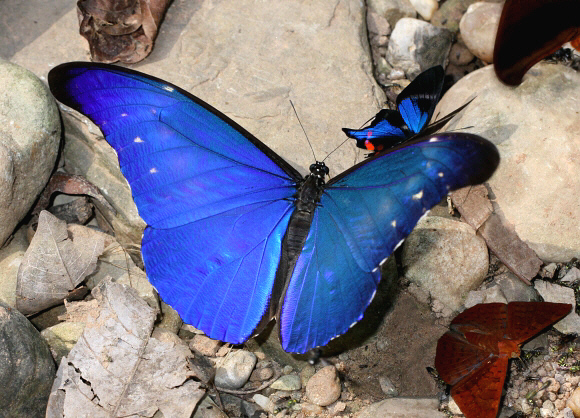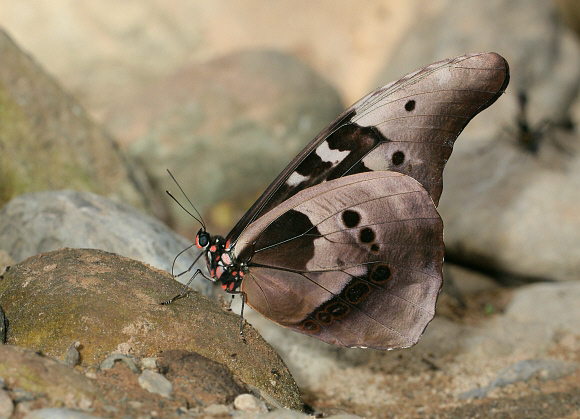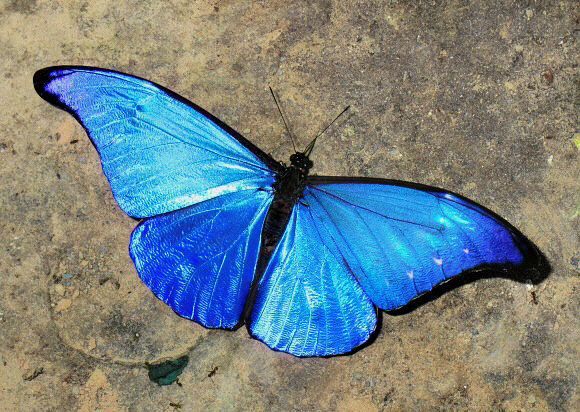
Introduction
It is a source of amusement to lepidopterists that the general public in Latin America always refer to every one of the Morpho species as if they were just one creature – “the Blue Morpho”. There are in fact at least 29 described species, possibly more, as the status of some subspecies is contended by some taxonomists who consider they should be elevated to the rank of full species.
The dazzling blue wings of Morpho butterflies are enormous relative to their body size, resulting in a very distinctive slow, bouncy flight pattern. The effect is that the brilliant blue upperside appears to flash like a beacon as it alternates in flight with the dark undersurface. This makes it difficult for a bird to follow the flight. If attacked when on the wing, the slow lazy flight pattern instantly changes into a wild swooping evasive manoeuvre, following which the butterfly dives into the forest where it instantly settles. A pursuing bird is still of course searching for a brilliant blue insect, but the Morpho snaps its wings shut, displaying the dark brown underside and foiling the bird’s search program. If the bird does manage to spot the settled butterfly it invariably aims its attack at the most prominent feature – in this case the ocelli, missing the body entirely and allowing the butterfly to escape.
The intense dazzling colour of Morpho rhetenor is impossible to convey in a photograph. The words of DeVries used to describe the closely related species cypris are highly appropriate: “The sight of this sailing blue orb against a rainforest background is truly one of the most stunningly beautiful in the neotropics”. The legendary naturalist Henry Walter Bates described the flight of rhetenor equally well: “When it comes sailing along it occasionally flaps its wings and then the blue surface flashes in the sunlight so that it is visible a quarter of a mile away”.
Morpho rhetenor is a widespread and fairly common species found from Colombia and Venezuela to Peru, Brazil and Bolivia. There are 6 described subspecies, of which 2 occur in Peru – cacica and helena. In Central America rhetenor is replaced by a similar species Morpho cypris.

Habitats
Morpho rhetenor is found in lowland rainforest and in the foothills of the eastern Andes, at altitudes between 0-1000m.

Lifecycle
The egg is hemispherical and pale green with a broken reddish ring around the upper half. It is laid singly on Inga ( Mimosaceae ). The fully grown larva is reddish with many fine olive and black lines, 2 large oval yellow patches on the back, and a pair of short tail prongs. It possesses a gland behind the head, which exudes a volatile odour if the larva is molested. The chrysalis is ovoid, smooth and pale green.
Adult behaviour
As with most Morpho species, males spend the mornings patrolling back and forth along the courses of streams and rivers. On warm sunny afternoons they can sometimes be found imbibing moisture from damp sand, visiting sap runs, or feeding at rotting fruit. When feeding or resting the wings are kept firmly closed, but are erratically flicked open and shut in response to disturbance by ants and wasps. The action is so rapid that obtaining a photograph capturing the precise fraction of a second when the wings are fully open is almost impossible.
Unfortunately this is a species that is highly prized by collectors. In Peru and elsewhere these huge and magnificent creatures are killed in considerable numbers for the souvenir trade – good quality specimens find their way into display boxes that are sold in major towns, cities and airports, and probably fail to survive the journey back to their purchaser’s homes intact. Damaged specimens are used by the jewellery trade to make anything from earrings to paperweights.
